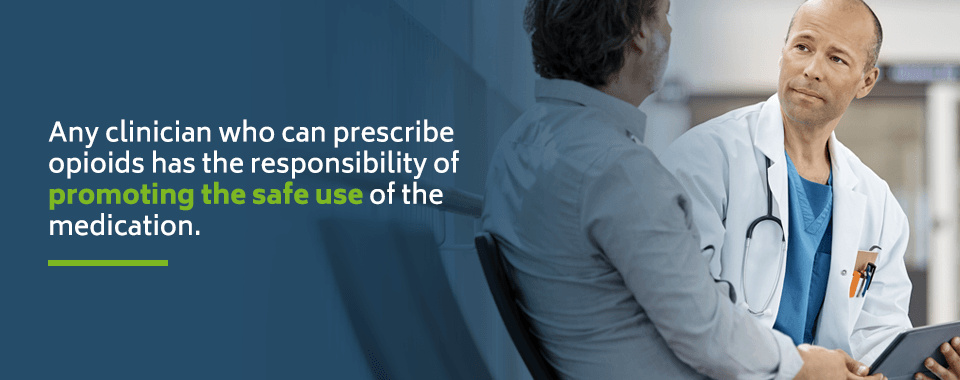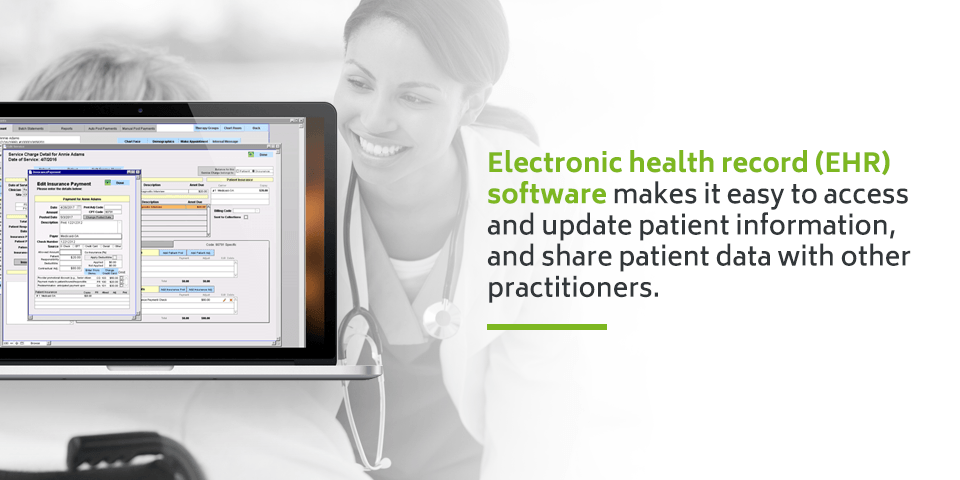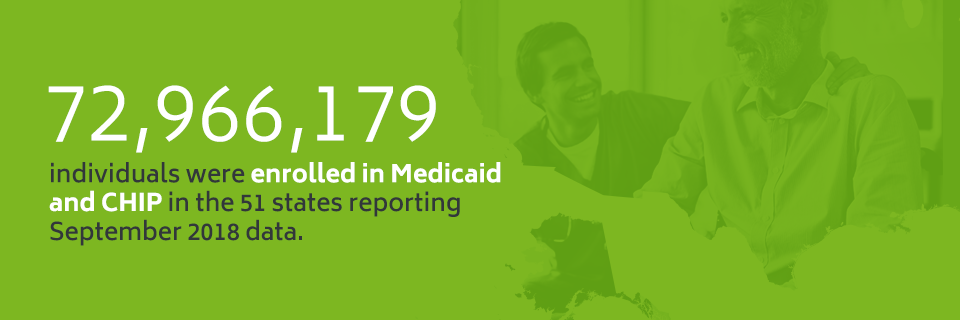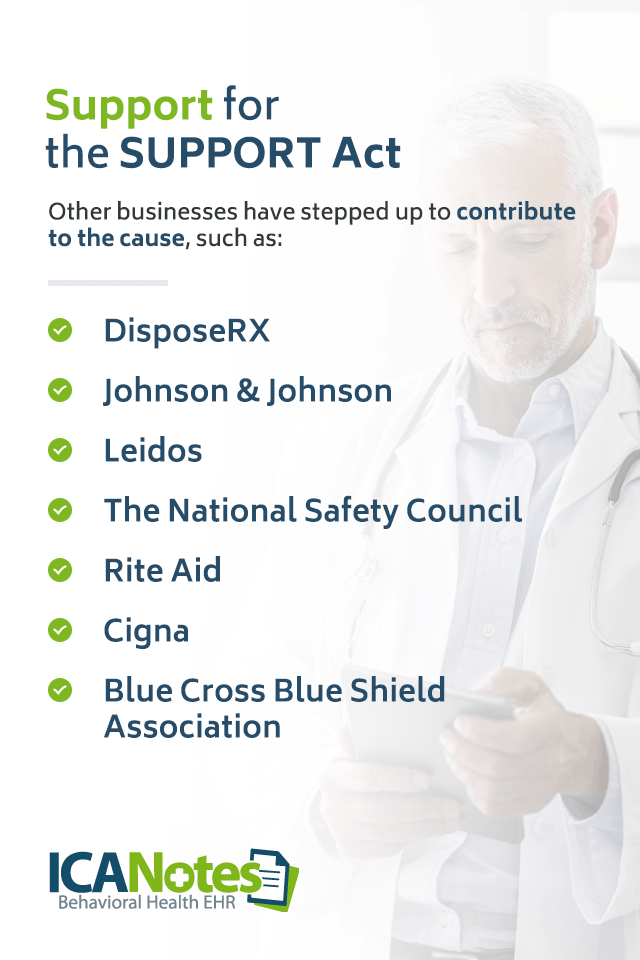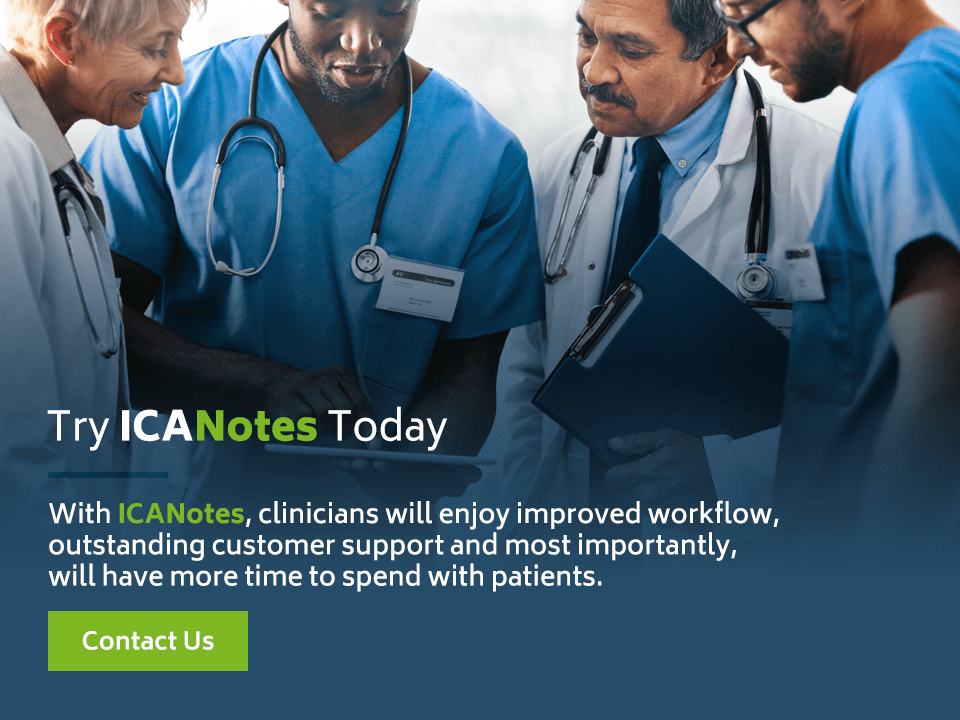SUPPORT Act for Opioid Recovery: Effects on Healthcare and Clinicians
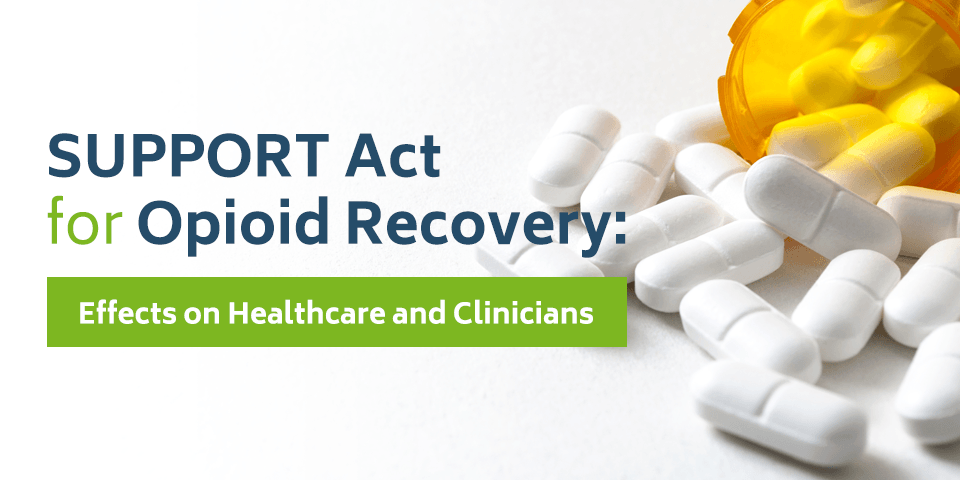
The opioid epidemic affects the lives of millions in the United States, and according to the National Institute on Drug Abuse (NIDA), over a hundred Americans die every day from an opioid overdose. Many Americans are dealing with the pain of losing a loved one to opioid addiction. All Americans miss out on the social and economic contributions lost individuals could have made. Opioid dependence, in general, adds to the nation’s financial burden. It’s estimated that the country loses over $78 billion a year to cover costs relating to prescription opioid misuse. These costs include health care expenses, addiction treatment, criminal justice costs and lost productivity.
With a recognized need to combat the opioid epidemic, President Trump signed the Substance Use-Disorder Prevention that Promotes Opioid Recovery and Treatment for Patients and Communities Act, also called the SUPPORT for Patients and Communities Act. This healthcare act became public law on October 24, 2018. The purpose of the act is to help prevent opioid use disorder and provide recovery and treatment.
In this article, we will navigate the SUPPORT Act and consider ways the act will affect healthcare professionals, including behavioral health workers who must follow mental health policies. We’ll also discuss the benefits and potential problems of the act.
What Is the SUPPORT Act?
The SUPPORT Act includes dozens of different bills, all aiming to end the opioid crisis. The act affects every sector of the healthcare industry, from family medical practices to health insurance companies. Most importantly, the act impacts patients. Perhaps the most significant impact of the act is that it removes restrictions for Medicare and Medicaid patients in need of opioid addiction treatment and aims to stop the overprescribing of opioid medications.
Other highlights include:
- The act temporarily requires coverage of medication-assisted treatment for patients with Medicaid
- Certified opioid treatment programs are now covered for patients with Medicare
- Medicare enrollees must undergo an initial examination which includes screening for an opioid use disorder
- Prescriptions for controlled substances must be sent through electronic prescription programs
- Children’s Health Insurance Program (CHIP) plans must cover mental health and substance use disorder services and should not be treated differently than other medical issues covered under CHIP
- Healthcare providers must check a Medicaid enrollee’s prescription history in the prescription drug monitoring program (PDMP) before prescribing controlled substances
- The Centers for Medicare and Medicaid Services (CMS) must provide educational resources to Medicare beneficiaries regarding opioid use, pain management and opioid alternatives
- The act supports the National Institutes of Health (NIH) using cutting-edge research in response to a public health threat
- The act creates a loan repayment program for individuals who work in substance use treatment programs in shortage areas or where drug overdose deaths are high
- The act requires the Substance Abuse and Mental Health Services Administration (SAMHSA) to award grants to create or operate at least 10 opioid recovery centers across the country
- The act exempts substance-use disorder telehealth services from certain Medicare requirements
- The act increases the number of patients clinicians may treat using medication-assisted treatment (MAT)
- The CMS must also establish a secure online portal to allow data sharing and prevent or investigate fraud, waste or abuse
Overall, the SUPPORT Act aims to discover alternative non-addictive pain medications, educate Americans and physicians about opioid abuse and help Americans gain access to opioid addiction treatment. Lastly, the act strives to reduce the number of opioids circulating the population.
How Does the Act Affect the Healthcare Industry and Clinicians?
The effects of the SUPPORT Act reach far and wide. Any clinician who can prescribe opioids has the responsibility of promoting the safe use of the medication. Mental health professionals can work with other health care providers to develop treatment plans that help patients with both addiction issues and chronic pain, and the SUPPORT Act aims to make coordination of care easier.
In general, all realms of the healthcare field can expect a focus on the opioid crisis, and extra funding may help bring new patients to practices all over the country. Although the effects of the SUPPORT act are yet to be discovered, here are five possible ways the act will affect the healthcare industry.
1. Clinicians Will Prescribe Opioids With Extreme Caution
Any clinician should first review a patient’s opioid history in the PDMP. This will help prevent prescribing an opioid to a patient who has opioid use disorder or who may already have an opioid prescription from another doctor. Clinicians can expect to be more closely monitored as government health agencies will be on the lookout for overprescribing, fraud and abuse. The Centers for Disease Control and Prevention (CDC) has created guidelines to help clinicians determine when an how to prescribe opioids.
These guidelines include that clinicians should:
- Only prescribe opioids if the expected benefits outweigh the risks for the patient, and should consider non-opioid medications and physical therapies first
- Establish treatment goals with patients before prescribing opioid therapy, and have a plan if they choose to discontinue therapy
- Educate patients about the risks and benefits of opioid therapy before and during therapy
- Prescribe the lowest effective dose possible
- Prescribe opioids in quantities no more than what is needed, often less than a three-day supply and rarely more than seven
- Evaluate risk factors and consider including naloxone in a pain management plan for patients at risk of opioid addiction or misuse
- Consider administering drug testing before prescribing opioids to test for other prescription medications
- Not prescribe opioids and benzodiazepines simultaneously if possible
- Offer treatment for opioid use disorder
By following the above guidelines, clinicians can help prevent opioid addiction or overdose, while still helping patients manage pain. Depending on your state laws, you may be required to check the PDMP before prescribing opioids to any patient, whether they are enrolled in Medicaid or not. Checking the PDMP before prescribing opioids could save lives, yet many physicians have failed to do so in the past. For example, in 2014, a survey found that only 53 percent of primary care physicians used the PDMP.
2. Clinicians Can Expect Improved Electronic Health Record Systems
Electronic health record (EHR) software makes it easy to access and update patient information, and share patient data with other practitioners. This can be instrumental in combating the opioid crisis, especially if clinicians can view a patient’s history quickly and easily.
The U.S. Department of Health and Human Services (HHS) recommends that EHR software integrates PDMP data, to remove barriers to accessing patient substance use history. This will help doctors conveniently check a patient’s past and determine if an opioid prescription will do more harm than good. Integrated PDMP data will also promote interoperability between health care providers. Patients will enjoy improved care, and physicians should experience better workflow as a result.
3. Treatment Centers Can Expect More Clients
Millions of Americans are covered by Medicare, CHIP and Medicaid. According to a September 2018 report, nearly 73 million individuals were enrolled in Medicaid and CHIP, for example. Medicare and Medicaid enrollees can now expect easier access to substance use disorder treatment and improved coverage of related services. This may translate to an influx of patients for treatment centers around the country.
However, inpatient rehabilitation centers are not the only entities affected by the act. The HHS aims to increase the number of providers who can offer patients MAT, including nurse practitioners and physician assistants to make MAT available on demand. The HHS also strives to improve behavioral health providers’ knowledge about substance use disorders. The HHS’s mission will impact psychiatrists, social workers, primary care providers and many others who are willing to undergo training and provide MAT. The act requires state Medicaid plans to cover the cost of MAT up until 2025.
4. Clinicians Can Expect a Rise in Telehealth Visits
Telehealth provides health care and education via telecommunications technology. This might involve video conferencing with patients instead of requiring them to come into an office. Under the act, Medicare patients are no longer restricted by their location and may receive telehealth services regardless of where they live.
Telehealth may play a critical role in combating the opioid epidemic. According to the American Journal of Public Health, opioid misuse is concentrated in states with large rural populations, such as Kentucky, West Virginia and Oklahoma. Perhaps one of the reasons rural areas have been hit hard by the opioid crisis is a lack of access to treatment.
A study funded by the NIH identified barriers to substance use disorder treatment. According to this study, some of the reasons individuals do not seek treatment include living too far away from a treatment center, not knowing where to get treatment and having to wait too long to start. Telehealth services may help remove several barriers standing in the way of treatment. Clinicians might consider ways to reach patients in rural areas using telecommunications.
Support for the SUPPORT Act
The SUPPORT Act has the potential to greatly help eliminate the opioid epidemic by removing treatment barriers, spreading awareness and combating the crisis from all sides. The SUPPORT Act helps secure the funding needed to accomplish the goals established in the act.
For example, the CDC recently awarded $155 million to states to fight the opioid epidemic and has distributed an additional $27 million to nine organizations to help support staffing and training. The CDC has several goals to prevent opioid-related deaths, including increasing public awareness about the risks.
Other businesses have stepped up to contribute to the cause, such as:
- DisposeRX: DisposeRX will give packets to remove more than 10 million opioids from the population. DisposeRX packets offer a simple, convenient solution to medication disposal, so patients can get rid of expired or excess opioids and reduce temptation.
- Johnson & Johnson: Johnson & Johnson will educate nurses and physicians to battle opioid abuse.
- Leidos: Leidos will donate $3 million to support the act.
- The National Safety Council: The National Safety Council will educate more than 1000 physicians about prescribing practices.
- Rite Aid: Rite Aid will offer free DisposeRX packets with new opioid prescriptions.
- Cigna: Cigna is partnering with the Veterans Health Administration to improve access to treatment programs.
- Blue Cross Blue Shield Association: Blue Cross Blue Shield Association will establish a free national hotline to help individuals locate treatment centers.
Potential Disadvantages of the SUPPORT Act
Although the SUPPORT Act can make a difference in the lives of millions of Americans affected by the opioid crisis, it does have a few disadvantages. Mainly, clinicians may fear criminal charges, investigations or overprescribing opioids so much that they avoid prescribing opioids altogether. This can have a negative impact on patients who suffer from severe chronic pain, as opioids are highly effective at relieving pain. Physicians may feel conflicted about when and how to prescribe opioids and will face a lot of pressure when making decisions regarding pain management.
Also, the SUPPORT Act authorizes the U.S. Food and Drug Administration (FDA) to require some opioids be dispensed in a blister pack, limiting how many pills clinicians can distribute at once. This level of control should not be a problem for patients who only need pain medicine for a few days. However, dispensing requirements could lead to standardization of doses and make it more difficult for patients to receive refills when they are still experiencing pain after surgery or trauma.
Some hope the SUPPORT Act focuses on limiting the opioid supply and encouraging clinicians to address the issue that affects millions of Americans every day. Despite the need to combat the opioid epidemic, individuals with chronic pain should still be treated with compassion.
Another issue with the SUPPORT act is that certain privacy elements — namely 42 Code of Federal Regulations Part 2 — can be highly restrictive to patient health care. Before the act made its last pass through Congress, provisions meant to normalize the disclosure of substance use disorder medical records for purposes related to treatment were removed. The change was intended to remove mental health legislation requiring a treatment program to have the patient’s consent before sharing information with others, instead requiring clinicians treating patients for substance use disorder to comply with only one act’s privacy rules — HIPAA.
Eliminating 42 CFR Part 2 was also meant to make it easier for health care providers to share a patient’s substance use history, allowing for better patient care across the board. Since the act was left in, privacy restrictions will remain in place, making the overall sharing process more difficult and restrictive.
Try ICANotes Today
With thousands of Americans dying every year from an opioid overdose, it’s time for healthcare professionals and legislators to combine forces and beat an epidemic that has afflicted the country for too long. The SUPPORT Act prioritizes ending the opioid epidemic and gives hope to communities large and small.
Behavioral health professionals are key players in the battle against opioid addiction. Counselors, psychologists and psychiatrists can help patients get to the root of their addiction, and learn healthier strategies to cope with life stressors or mental health issues. As a result of the SUPPORT Act, mental health workers can expect improved communication with other health care providers in the future, including using more intuitive EHR in their practice.
ICANotes is behavioral health EHR which promotes compliance with mental health legislation and simple, efficient, confidential and accurate note-taking. With ICANotes, clinicians will enjoy improved workflow, outstanding customer support and most importantly, will have more time to spend with patients. To learn more, contact us today or start your free trial.
Related Posts
The Importance of the Senate Expanding Training for School Mental Health Professionals
How Telemedicine Could Play a Major Role in Mental and Behavioral Health Care
2018 Updates to the EHR Incentive Program
How Electronic Health Records Are Improving Patient Care
Sources:
https://www.drugabuse.gov/drugs-abuse/opioids/opioid-overdose-crisis
https://www.congress.gov/bill/115th-congress/house-bill/6
https://www.congress.gov/bill/115th-congress/house-bill/6/actions
https://www.congress.gov/bill/115th-congress/house-bill/6/text
https://www.natlawreview.com/article/kickbacks-aren-t-illegal-just-federal-health-care-programs-recently-enacted-support
https://www.painnewsnetwork.org/stories/2018/10/26/what-will-support-act-mean-for-pain-patients
https://www.ama-assn.org/delivering-care/opioids/10-ways-new-opioids-law-could-help-address-epidemic
Federal Legislation to Address the Opioid Crisis: Medicaid Provisions in the SUPPORT Act
https://www.usatoday.com/story/news/nation-now/2018/07/01/michigan-florida-tennessee-law-opioid-prescription/749216002/
https://www.cdc.gov/drugoverdose/pdf/guidelines_at-a-glance-a.pdf
https://www.cdc.gov/
https://ehrintelligence.com/news/prescription-drug-monitoring-program-use-mandatory-for-ca-docs
https://www.healthit.gov/playbook/opioid-epidemic-and-health-it/
http://journal.ahima.org/wp-content/uploads/2017/11/AHIMA-Opioid-Addiction-Tip-Sheet.pdf
http://journal.ahima.org/
https://www.hhs.gov/opioids/sites/default/files/2018-09/opioid-fivepoint-strategy-20180917-508compliant.pdf
https://www.hhs.gov/ash/advisory-committees/pain/meetings/2018-09-25/recomendations-and-gaps/index.html
https://www.medicaid.gov/medicaid/program-information/medicaid-and-chip-enrollment-data/report-highlights/index.html
https://www.aamc.org/advocacy/washhigh/highlights2018/493024/102618presidentsignsopioidsbillintolaw.html
https://www.healthit.gov/faq/what-telehealth-how-telehealth-different-telemedicine
https://www.natlawreview.com/article/support-act-expands-telehealth-treatment-substance-use-disorders
https://www.ncbi.nlm.nih.gov/pmc/articles/PMC3935688/
https://www.cdc.gov/media/releases/2018/p0919-cdc-opiod-battle-funding.html
https://www.beckershospitalreview.com/opioids/president-trump-signs-opioid-bill-into-law-21-companies-pledge-support.html
https://disposerx.com/
https://www.healthleadersmedia.com/clinical-care/patients-chronic-pain-feel-caught-opioid-prescribing-debate
https://www.ncbi.nlm.nih.gov/pmc/articles/PMC5494184/
https://www.hhs.gov/opioids/sites/default/files/2018-09/opioid-fivepoint-strategy-20180917-508compliant.pdf
https://www.samhsa.gov/health-information-technology/laws-regulations-guidelines
https://www.healthcare-informatics.com/blogs/rajiv-leventhal/privacy/new-opioids-legislation-patient-privacy-holds-serve
https://www.ncbi.nlm.nih.gov/pmc/articles/PMC1986793/

